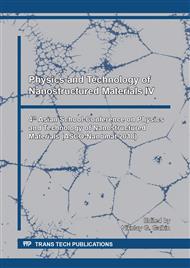[1]
Begum G., Goodwin W.B., deGlee B.M., Sandhage K.H., Kröger N. Compartmentalisation of Enzymes for Cascade Reactions through Biomimetic Layer-by-Layer Mineralization // J. Mater. Chem. B 3 (2015) 5232-5240.
DOI: 10.1039/c5tb00333d
Google Scholar
[2]
Delalat B., Sheppard V., Rasi Ghaemi S., Rao S., Prestidge C., McPhee G., Rogers M.-L., Donoghue J., Pillay V., Johns T., Kröger N., Voelcker N. Targeted drug delivery using genetically engineered diatom biosilica // Nat. Commun. 6 (2015) 8791.
DOI: 10.1038/ncomms9791
Google Scholar
[3]
Golokhvast, K.S., Seryodkin, I.V., Chaika, V.V., Zakharenko, A.M., Pamirsky, I.E. Phytoliths in Taxonomy of Phylogenetic Domains of Plants // BioMed Research International 2014 (2014) 648326.
DOI: 10.1155/2014/648326
Google Scholar
[4]
Golokhvast K.S., Seryodkin I.V., Bulakh E.M., Chaika V.V., Zakharenko A.M., Kholodov A.S., Pamirsky I.E., G. Chung Mycoliths morphotypes and biosilification proteins in wood-destroying and pileate fungi // Botanica Pacifica 7 (2018) 1.
DOI: 10.17581/bp.2018.07102
Google Scholar
[5]
Kotzsch A., Gröger P., Pawolski D., Bomans P.H.H., Sommerdijk N.A.J.M., Schlierf M., Kröger N. Silicanin-1 is a conserved diatom membrane protein involved in silica biomineralization // BMC Biol. 15 (2017) 65.
DOI: 10.1186/s12915-017-0400-8
Google Scholar
[6]
Madella, M., Alexandre, A., Ball, T. International code for phytolith nomenclature 1.0. // Annals of Botany 96 (2) (2005) 253-260.
DOI: 10.1093/aob/mci172
Google Scholar
[7]
Muller W.E.G., Schreder H.C., Burghard Z., Pisignano D., Wang X. Silicateins - A novel paradigm in bioinorganic chemistry: Enzymatic synthesis of inorganic polymeric silica // Chemistry - A European Journal 19(19) (2013) 5790-5804.
DOI: 10.1002/chem.201204412
Google Scholar
[8]
Pamirsky I.E., Golokhvast K.S. Silaffins of diatoms: from applied biotechnology to biomedicine // Marine Drugs 11 (2013) 3155-3167.
DOI: 10.3390/md11093155
Google Scholar
[9]
Piperno, D.R. Phytoliths: A Comprehensive Guide for Archaeologists and Paleoecologists. AltaMira Press, Lanham, Md, USA. (2006).
Google Scholar
[10]
Raven J.A., Knoll A.H. Non-skeletal biomineralization by eukaryotes: matters of moment and gravity // Geomicrobiology Journal 27(6&7) (2010) 572-584.
DOI: 10.1080/01490451003702990
Google Scholar
[11]
Schoeppler V., Reich E., Vacelet J., Rosenthal M., Pacureanu A., Rack A., Zaslansky P., Zolotoyabko E., Zlotnikov I. Shaping highly regular glass architectures: A lesson from nature // Sci. Adv. 3(10) (2017) (2047).
DOI: 10.1126/sciadv.aao2047
Google Scholar
[12]
Skinner H.C.W. Biominerals // Mineralogical Magazine 69(5) (2005) 621-641.
Google Scholar


